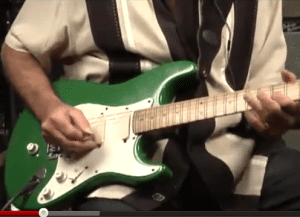I’ve got a tasty lesson for you today
from Jimmy Dillon.
We are gearing up for his latest, greatest
publication – Eclectic Electric II.
Yes, II as in “2”…
This will be the 6th Jimmy Dillon course.
We keep filming him because he really
keeps on delivering the goodies.
Today’s lesson is no exception. Check it out:
Okay, that was obviously a cool little
funk thing in A minor. I went a couple
of different places with that.
I started out with sort of a James Brown,
Wah Wah Watson kind of thing. That had not
quite as much distortion on it, more of a
rhythm sound. So this is kind of
like a minor 6th chord, very easy
to do. All you’ve got to do is just
lay your 1st finger here and then move
your pinkie here, or your 3rd finger if
you choose. I like doing the pinkie
because it allows me to use my other
fingers along the way. That’s just a
way of coloring the A minor.
Now, what I did is I played
a melody, I went… A very simple,
minor lick there. Once again, we always
talk about the root. If you want to play
it safe and you’re just learning a song or
you just want to know that some thing’s going
to work, if you’re in the key of A minor, play
that A. We’ve done this over and over again
and I keep trying to hammer it home. If you
start with the root note you can never
go wrong. So that’s a rule you can live by.
In this case we’re playing A minor,
a very simple, I IV sharp V progression.
So if you know you’re in A minor, why not
start with the high A and then just do a
descending line? You’re probably
familiar with that. You’ve heard that
lick before. I could probably name 10 songs
that utilize that lick. Bob Marley,
“I Shot the Sheriff” uses that type of lick.
This is a trick that I want to share
with you, too. Sometimes if I’m at a
loss of what to play I’ll just try
and search-out a very simple melody,
especially over a groove like this,
rather than getting tricky with it or
trying to get something fancy — and
we all do this, believe me. Every guitar
player I know does this. We’ll be playing
somewhere and we want to try and do
something fancy, but the truth is, if
you want to be effective and really nail it,
you’re better off doing a really simple lick.
Even if you’re just a beginner, this is still
something you can groove on and really
have fun with.
My lick, again, was just… Now,
when I went to the D chord, that’s
the IV of the A minor progression,
it takes you from your D chord, your D minor,
and then you do that lick right back to your A.
So you’re back to your root again. Okay?
Now, the next part is a little bit tricky.
What I did was a sharp 5, which is an F and
then I went to an E. And back to the 1.
Now the reason I did that, I like — I have
a great affinity for sharp 5 chords in
a minor progression. And don’t let that
scare you; it’s not complicated. If you
can count one, two, three, four, five,
you know that your one is your A minor,
your four is your D minor and your five
is your E minor. So a sharp five
would be your F.
In this case, you can check
out my F7th. Now, we’ve talked a
lot about partials along the way here.
This is another partial. You don’t have
to hit a whole chord all the time, especially
if you’re playing with a band. This triad will
suffice. That’s a nifty little
chord to have in your arsenal. And then
simply go down a half step. And the
bonus is, you get to pick-up the low E.






